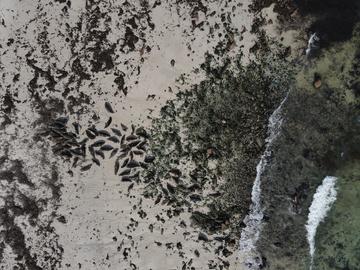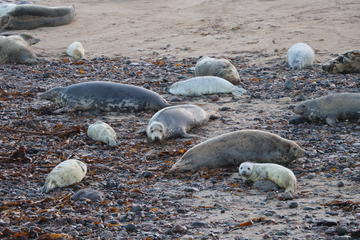
Drone shot of a seal colony in the Isles of Scilly
Image: Thomas Stone
To understand how populations change over time and how they respond to threats like climate change, we can use demographic data – information on the size and structure of a population. However, getting direct measurements from some species, like marine mammals, is difficult. New research provides a way to estimate the 3D body size of pinnipeds (seals, sea lions, and walruses) at the colony scale, which improves our ability to monitor them and make effective decisions about their conservation.
The new technique uses unmanned aerial vehicles – drones – flying in a transect (straight line) pattern. By using drones, the method allows researchers access to remote areas, eliminating the need to approach, sedate, and handle dangerous or threatened species. Because the drone is moving as it takes photos, the drone camera can capture the pinniped colony from a range of different locations and angles. This makes it possible to reconstruct a geometrically accurate, 3D representation of the colony using the photos – the drone knows the exact distance it is from the ground, and therefore the exact distance that each pixel in the photo represents in real life. Thomas Stone, lead author who completed this research as part of a Masters at the Department of Biology, said:
“Demographic data are either lacking or insufficient for many species; often they are either hard to approach or doing so can disturb the animals. Our method uses drones to capture this data through 3D structure-from-motion photogrammetry, minimising disturbance to animals, and is both time- and cost-effective.”

Grey seals with pups in the Farne Islands
Image: Thomas Stone
The ability to estimate the 3D body size of pinnipeds at the colony scale opens new avenues for research. These include assessing the health of individuals, comparing the health of different colonies or populations, tracking how individual health changes through time, and detecting how environmental conditions affect colony health. In addition, obtaining individual-level data at scale is important to capture differences in ‘vital rates’ such as survival and growth, which are key aspects of population viability. Continuous traits such as body size can be good predictors of these vital rates, as they provide key insights into the underlying mechanisms that shape an individuals’ fitness.
The researchers tested their method in the field on grey seal (Halichoerus grypus) colonies in the Isles of Scilly and the Farne Islands, both in the UK, as well as on an inflatable model of known volume that was of similar shape and size to a seal. The results showed that they could successfully estimate size for up to 68% of adults in a colony at optimal altitudes. Thomas added:
“Although we were applying the approach to pinnipeds, the method could be adapted to other groups that are challenging to obtain direct measurements from. It therefore has the potential to fill demographic research gaps much more widely, which will improve our ability to protect and conserve species into the future.”
The researchers next plan to automate the image analysis and volume estimation steps of the pipeline to increase the speed at which volume estimates can be obtained. Data collected using these new methods could help predict the impact of potential threats to UK grey seal populations, such as climate change.
To read more about this research, published in Methods in Ecology & Evolution, visit: https://doi.org/10.1111/2041-210X.14457